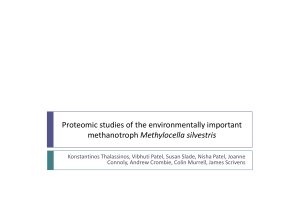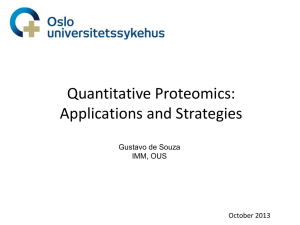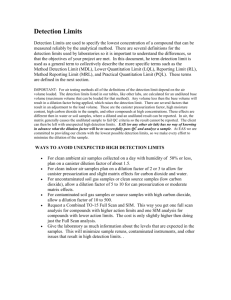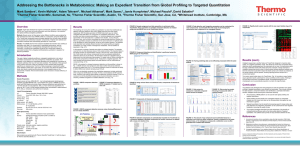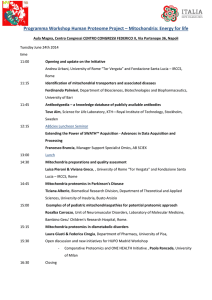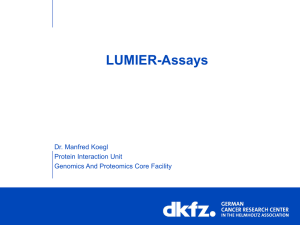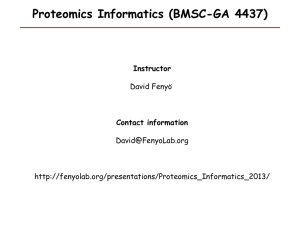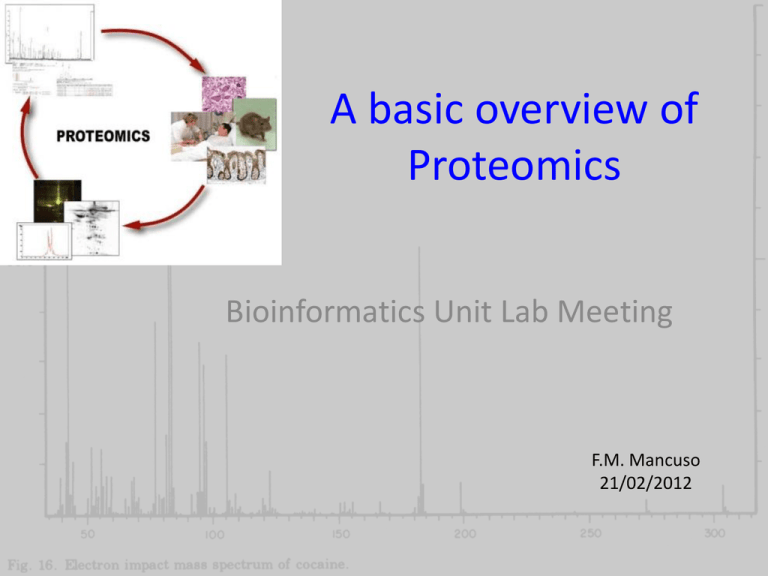
A basic overview of
Proteomics
Bioinformatics Unit Lab Meeting
F.M. Mancuso
21/02/2012
The proteome is defined as the set of all expressed proteins in a cell,
tissue or organism (Wilkins et al., 1997).
Proteomics can be defined as the systematic analysis of proteins for
their identity, quantity and function.
Why proteomics?
Protein alterations cannot be fully deduced from DNA.
RNA expression does not always reflect protein levels (i.e. translational control,
degradation, turnover,…)
Some tissues not suitable for RNA expression analysis.
Proteins are the physiological/pathological active key players.
General goal:
better understanding of genesis and progression of diseases
Clinical goals:
early disease detection (biomarkers)
identification of therapeutic targets
therapy monitoring
Applications of Proteomics
• Mining: identification of proteins (catalog the proteins)
• Quantitative proteomics: defining the relative or
absolute amount of a protein
• Protein-expression profile: identification of proteins in
a particular state of the organism
• Protein-network mapping: protein interactions in living
systems
• Mapping of protein modifications: how and where
proteins are modified.
Top down or bottom up?
Bottom-up
•
Fragment
ions of
peptides
MS/MS
Proteolytic digest
e.g. Trypsin
Bottom-up
– Most common
– Starting with proteolytic
fragments
– Piecing the protein back
together
• de novo repeat
detection
Top down
– Tandem MS of whole
protein ions
• Pulling them apart
– Electron capture
dissociation
– Extensive sequence
information
Protein
MS/MS
Fragment
ions of
protein
Top down
•
”Protein mass spectrometry" Wikipedia, The Free Encyclopedia. Wikimedia Foundation, Inc.
Typical MS experiment (I)
Protein
Identification
(and
quantitation)
Typical MS experiment (II)
Cells, tissue
HPLC
MALDI, ESI
TOF, Q, IT
Algorithms
Mass Spectrometry (MS) Stages
• Introduce sample to the instrument
• Generate ions in the gas phase
• Separate ions on the basis of differences in m/z with
a mass analyzer
• Detect ions
Vacuum
System
Samples
Ionisation
Method
HPLC
MALDI
ESI
Mass
Analyser
Detector
Data
System
Mass spectrometers used in proteomic
research
Aebersold R. and Mann M., Nature (2003)
Data acquired - Chromatogram
NL: 2.83E9
47.64
100
TIC MS
RS_Contest_04
90
80
70
60
50
40
75.81
57.90
30
82.90
74.48
20
104.24
111.77
134.78
46.01
3.39
10
26.43
140.20
0
146.61
160.29
181.98
206.18
NL: 4.22E8
47.97
100
Base Peak m/z=
400.0-2000.0 F: + c
90
Full ms [
80
400.00-2000.00]
MS RS_Contest_04
70
60
83.07
50
40
30
70.11
82.07
85.56
46.01
102.41
126.89
20
29.48
10
19.24
43.63
134.78
144.13
27.29
163.97
172.59
181.98
197.48
0
0
20
40
60
80
100
Time (min)
120
140
160
180
200
Tandem mass spectrum
Tandem mass spectra (MS/MS) can be used for
peptide sequencing
- Database Searching
- De novo sequencing
Mascot
– Scoring based on peptide frequency distribution from a non-redundant database
(MOWSE – Molecular Weight SEarch)
– The significance of that result depends on the size of the database being
searched. Mascot shades in green the insignificant hits using a P=0.05 cutoff.
Quantitative Proteomics
Kumar et al., FEBS Letters (2009)
Relative quantitation methods
i.e. SILAC
i.e. ICAT
i.e. iTRAQ,
TMT
Label-free analysis
Isotopic labeling
Quantitation methods (II)
Yates JR, et al. Annu Rev Biomed Eng. (2009)
Quantitation methods (III)
Common quantitative MS workflows
Boxes in blue and yellow represent two experimental conditions. Horizontal lines indicate when samples are combined.
Dashed lines indicate points at which experimental variation and thus quantification errors can occur.
Bantscheff et al., Anal Bioanal Chem (2007)
Generic data processing and analysis workflow
for quantitative MS
Yellow icons indicate steps common to all quantification approaches with or without the use of stable isotopes. Blue icons in the boxed area
refer to extra steps required when using mass spectrometric signal intensity values for quantification.
Bantscheff et al., Anal Bioanal Chem (2007)
Exploring quantitative proteomics data using
bioinformatics
Bantscheff et al., Anal Bioanal Chem (2007)
Kumar et al., FEBS Letters (2009)
Protein Quantitation Tool
APEXprotein abundance estimate from LC-MS/MS data Java
ASAPRatio (TPP)
statistical analysis of protein ratios from ICAT, cICAT, SILAC experiments C++
DAnTE
protein quantitation, statistical analysis and visualization
.NET, R
isobar
quantitation of TMT and iTRAQ data and LaTeX report generation R
IsobariQ quantitation of IPTL, iTRAQ and TMT-labeled peptides C++
Libra (TPP)analyzes 4- and 8-channel iTRAQ data
MaxQuant quantitation from SILAC data from Thermo Orbitrap and FTICR
MFPaQ Mascot file parsing and quantitation using ICAT and SILAC
Perl/.NET
MSQuant protein quantitation combining Mascot results and raw data from stable isotope labeling .NET
MS-Spectre
quantitiave analysis of multiple LC-MS(/MS) analyses in mzXML Java
Multi-Q tool for multiplexed iTRAQ-based quantitation
.NET/Perl
muxQuant multiplexed quantitiave proteomics using differential stable isotope labeling C
PEAKS Q peptide/protein quantification by iTRAQ, ICAT, SILAC or label-free Java
pepXML2Excel converts output from PeptideProphet to protein level information in Excel
AWK
ProRata differential proteomics analysis using for various stable isotope labeling schemes
PVIEW
isotope labeled, label-free, XIC-based quantitation
C++
Quant
MATLAB program for protein quantitation by iTRAQ
MATLAB
QUIL another program for relative quantitation using stable isotope labeling
RAAMS algorithm for interpreting O-16/O-18 differential proteomics data C++
RelExcalculation of ion current ratios from LC-MS data (requires Xcalibur)
XPRESS (TPP) calculates relative abundances from ICAT, cICAT, SILAC and other N-14/N-15 experiments
Msnbase Base Functions and Classes for MS-based Proteomics R
…
Absolute quantitation (targeted proteomics)
Selected reaction monitoring (SRM) or multiple reaction monitoring (MRM) is a method
of absolute quantitation (also terms AQUA) in targeted proteomics analyses that is
performed by spiking complex samples with stable isotope-labeled synthetic peptides
that act as internal standards for specific peptides

